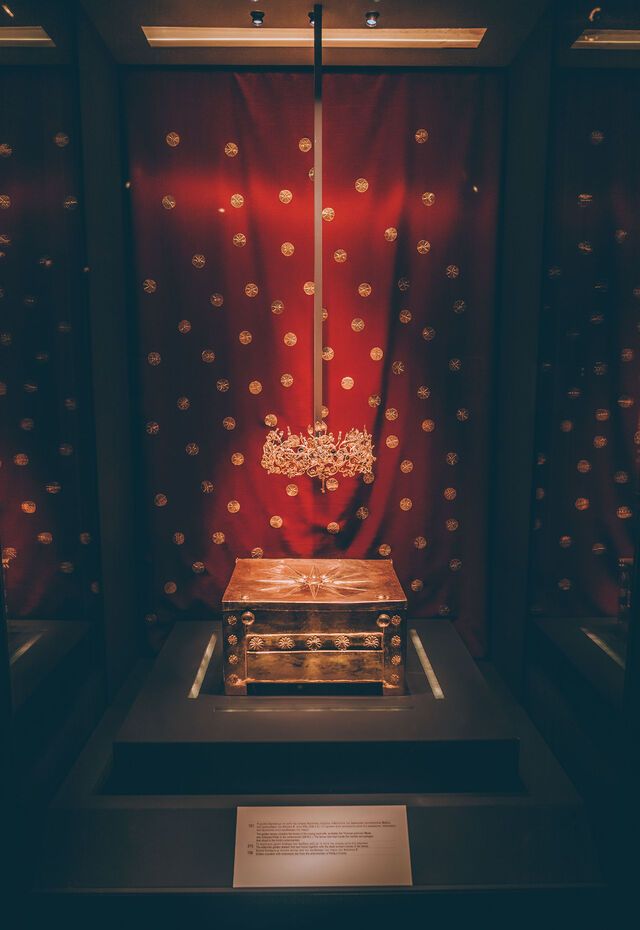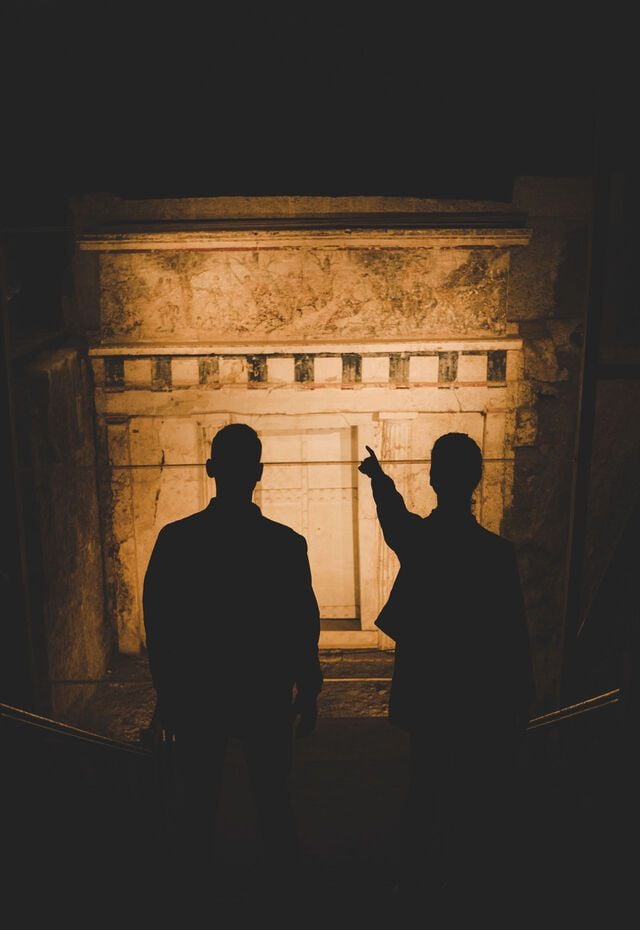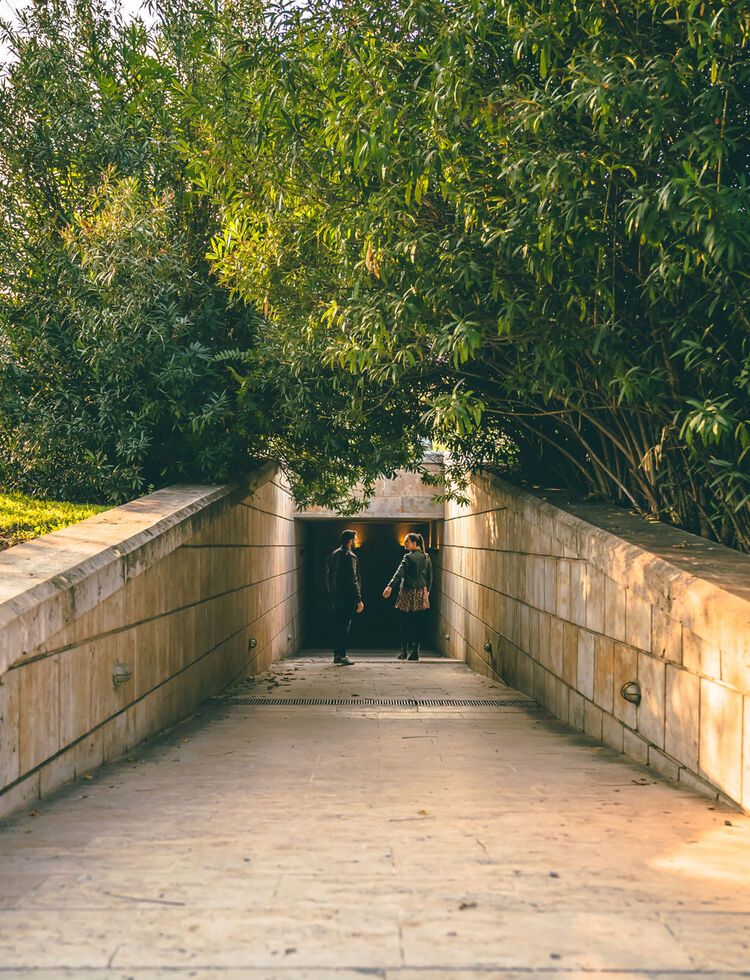Feel the majesty of Vergina’s Royal Tombs


OVERVIEW
Visiting the Royal Tombs at Vergina (ancient Aigai) is to travel to the epicentre of the famous Kingdom of Macedonia, which ruled supreme in Greece and far beyond in the 4th century BC.
This is where King Philip II of Macedon lived and died from 382-336BC and where his son, Alexander the Great, was crowned before setting out on his legendary empire-building quest.
Today, Vergina allows us to enjoy an extraordinary insight into the ancient capital of Macedonia. It’s not just an archaeological wonder, but one of the world’s great burial sites – alongside Mycenae, Troy and the Egyptian Valley of the Kings – because, like them, the most significant tombs (including that of Philip II) were discovered unlooted and virtually intact.
Only excavated in the 1970s and now a UNESCO World Heritage site, the royal tombs are presented within a grass-covered mound, mimicking the original burial tumulus of the Macedonians. Along with the palatial tomb of Philip II within it are those of Alexander’s teenage son (Alexander IV) and other family members, along with some of the most iconic treasures of Greek antiquity.
DON'T MISS
Tomb of King Philip II of Macedon
Philip II’s funeral ceremony in 336 BC was one of the most lavish of ancient times and his death chamber matched it in terms of glory. Something between a palace and a temple, it has standing columns and an antechamber. The portraits of himself and Alexander are depicted in a hunting scene on the tomb’s façade, as well as on the gold and ivory deathbed found in the chamber. Philip’s Thracian wife, Meda, was buried in the tomb’s antechamber.
The Theatre of Aigai
Like every place of importance in antiquity, Aigai had a theatre. But what makes this theatre special is that it appears to be the exact spot where Philip II was killed by a bodyguard while celebrating his daughter’s marriage, allowing Alexander to assume the throne and set in motion the rule that led to the accumulation of Greece’s famous empire, all the way to the Indus valley and into north Africa.
The Tombs of the Queens
Among the 300 smaller burial sites scattered around the site is one of the best-preserved female tombs of ancient Macedonia, known as the ‘Cluster of the Queens’. It contains one of the wives of Alexander I (498-454 BC), who was buried along with more than 20 small terracotta statues and what are believed to be the remains of Philip II’s mother (Eurydice) and daughter (Queen Thessaloniki).
The Palace
The glory of Aigai can be measured from the remains of the enormous palace which was constructed during the reign of Philip II. Built on a hill, it was three times the size of the Parthenon, with ground-floor banqueting rooms, and was visible for miles as a symbol of power and beauty. It set the standard for royal palaces for centuries to come.
The aura of the Museum
Perhaps your most vivid memory will be of the special aura of the site – collectively known as the Museum of Aigai. Nothing reflects this more than the exhibits within the tumulus – the gold larnax containing Philip II’s bones, the intricate golden wreath he wore on his funeral pyre, his immense armour and the treasure trove of jewellery and other artefacts from a golden age – all displayed in evocatively dimmed light.
GET PLANNING
From Thessaloniki to Vergina:
- By car: 70km (1hr)
- By bus (KTEL): from Makedonia Station via Veria (change bus). Regular daily service.
From Thessaloniki to Veria:
- By car: 73km (1hr5min)
- By bus: More info
- Regular daily service (1-1hr30min)
- By train: Via Platy. More info
From Athens to Veria:
- By car: 507km (5hr)
- By bus (KTEL): Kifissos Station (Athens) two services daily.
- By train: From Larissis Station (Athens) via Platy. More info
From Vergina to Veria
- By car or taxi: 13km (20min)
- By bus
- The archaeological site is open all year round (except national holidays).
- Seasonal opening hours apply
The best day trips from Thessaloniki
- Autumn
- Spring
- Summer
- Winter
- You will need around three hours to fully explore the museum and the site.
- Tickets: €15 (€8 reduced)
- The highlight of the museum in the underground burial mound, which has the benefit of being protected from both sun and rain. But the site is expansive, so wear comfortable shoes and season-appropriate clothes.
- As with any open-air archaeological site, it’s worth checking the weather conditions before you visit.
- A museum shop sells souvenirs, including original copies of Greek antiquities and publications.
- A café is open during museum operating hours.
- As far as amenities are concerned, nearby Veria offers very good accommodation, as well as modern and traditional cuisine.
- Suitable for visitors with disabilities.

